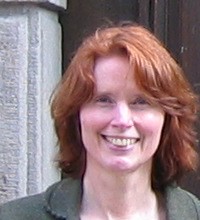We then moved on to the readings - and talked about how an essay's organization/order of presentation IS a central component of the content. The ordering of information and the relationships between juxtapositions create the reader's line of response. While the readers' construction of what an essay is about generally takes place at the unconscious level - it is powerfully present. You won't necessarily be able to construct a line of presentation that works at multiple levels to evoke the kind of complex story we found in Cofer's piece in your first draft = but stepping back, thinking through the parallels, contrasts, narrative (dis)continuities, gaps (for the reader to fill in) that writers create in the white space between sections will allow you to create more powerful, more artful writing as you revise.
In Cofer's piece we noticed the movement between two separate perspectives - the home video (a representation of family caught in the past - showing themselves at a particular point in time - without the ability to speak) - and Cofer's narrative recollections which included interpretations of her past life and of the movie. The while at first the two representations were distinct - by the conclusion they seemed to merge as Cofer dreamed herself into the movie. This structural move set me up , as a reader, to feel the inescapable connection between past identities (represented in the movie) and the interpretations of those identities. In the conclusion - they bring forward all their conflicts (in the personae of the different characters) while at the same time presenting themselves as part of a single, dream-logic conversation. The structural identification of the two perspectives (movie/Cofer's recollections) followed by the move to orchestrate them as a single cacophonous voice IS, in a sense, a kind of model for the feel/problem she represents in this text = her conflicting relationships to her Puerto Rican/American identities, her family, and her past.
Our list of the sections on the board documented some of the (lovely, artful) connections and transitions as she moved from section to section - the presentation of the women, the men, and the children - in the movie and her recollections. We might think of the sections as working to set up the physical spaces where we could visit the connected but separate perspectives at work in her past.
In his essay "Collage, Montage, Mosaic, Vignette, Episode, Segment," Robert Root names segmented structures in terms of the relationships between their sections. The following listing is taken from his essay, with a few modifications.
- juxtaposition - arranging one item alongside another item so that the comment back and forth on one another
- parallelism - altermating of intertwining one continuouse strand with another (a present tense strand with a past tense strand, a domestic strand with a foreign strand, etc)
- patterning - choosing an extra-literary design and arranging literary segments accordingly (for example, using the structure of/associations with the seasons, a musical piece, preparing a meal as the sequential frame for an essay)
- accumulation - arranging a series of segments or scenes or episodes so that they add to or enrich or alter the meanings of previous segments with each addition, perhaps reinterpreting earlier segments
- journaling - actually writing in episodes or reconstructing teh journal experience in drafts (this approach may include notes, earlier versions of the essay, reflections on how to revise earlier sections, etc.)
We have barely scratched the surface for working the connections between structure and meaning. Tonight's class really just opened the conversation. Hopefully each of you will write into the possibilities - both for Blog 4 - and in your essays.
For Monday
Blog 4: Do some exploratory writing to think about how you might develop an essay that uses segments to develop/enhance your focus. This doesn't have to be an essay you would actually write. Just do some on-the-page thinking about how you might use the form of an essay to set up a particular idea. You can use forms from the list above - or you can model your ideas on the segmented essays we've read so far (Grealy, Koesterbaum, Cofer, Simic, Atwood).
Read: "The Patch," by John McPhee, in The New Yorker, February 8,2010, p.32 - available through the Kean University Library Databases - click on periodicals, select The New Yorker.
In class on Monday we will continue to think about how CNF essays are built - only this time from a more narrative perspective - in terms of scenes, backstory, characterization riffs, and other devices.
Enjoy the beginning of fall (and the coming of those good smells!)

No comments:
Post a Comment